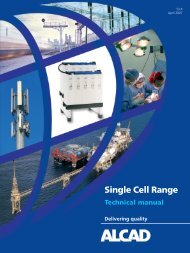Lead Acid Battery Operating Instructions - Alcad.com
Lead Acid Battery Operating Instructions - Alcad.com
Lead Acid Battery Operating Instructions - Alcad.com
Create successful ePaper yourself
Turn your PDF publications into a flip-book with our unique Google optimized e-Paper software.
9.2 Cell Appearance<br />
9.3 Water Additions<br />
9.4 Pilot Cell<br />
The room in which the battery is housed should be well ventilated and its temperature as<br />
moderate as the climate will allow. The temperature of the electrolyte should preferably<br />
never exceed 100°F (38°C).<br />
Examine all cells occasionally.<br />
Healthy cells, when fully charged, show a marked contrast between the dark brown<br />
positive and the light gray negative plates. For cells in transparent jars (SD, SDH, SGL,<br />
SGH), it can be useful to inspect the appearance of each cell in the battery at regular<br />
intervals.<br />
Any cells not showing a healthy plate coloration, or having a specific gravity or voltage<br />
noticeably lower than the other cells, or in which the plates gas unevenly or not at all,<br />
should be regarded as suspect. Such cells should be carefully examined for internal<br />
short<br />
circuits, such as may be caused by small pieces of scale bridging across lhe plates. Such<br />
short-circuits should be removed or the cell may be ruined.<br />
A period of charging will normally restore such cells to lhe condition of the remainder of the<br />
battery, but if it does not, expert advice should be obtained immediately from <strong>Alcad</strong><br />
Standby Batteries.<br />
Check the electrolyte levels in all cells regularly and if necessary top up with distilled or<br />
de-ionized water. Never allow the electrolyte level to fall below the "MIN" line. Do not<br />
overfill the cells.<br />
It is good practice to give the battery an equalize charge after water addition, to aid in<br />
mixing the electrolyte (see Section 7.3). Note that specific gravity readings are not<br />
meaningful following water addition; in fact, it may take six weeks or more before the<br />
solution is <strong>com</strong>pletely mixed.<br />
For regular monitoring of the battery condition, select one cell near the middle of the<br />
battery as a "pilot" cell (for batteries containing more than 60 cells, select one pilot cell for<br />
every 60 cells).<br />
The electrolyte specific gravity of the pilot cell(s)) will be indicative of the state of charge of<br />
the whole battery.<br />
10 Maintenance Records<br />
Written records should be kept of battery maintenance, so that long term changes in<br />
battery condition may be monitored.<br />
The following inspection procedures are re<strong>com</strong>mended:<br />
Weekly<br />
Monthly<br />
Check and record the overall float voltage at the battery terminals<br />
(not at the charger!), and measure the pilot cell voltage.<br />
Record the battery voltage and the voltage, specific gravity and<br />
temperature of the pilot cells.<br />
Quarterly Record the voltage, specific gravity and temperature of all cells.<br />
-8-



